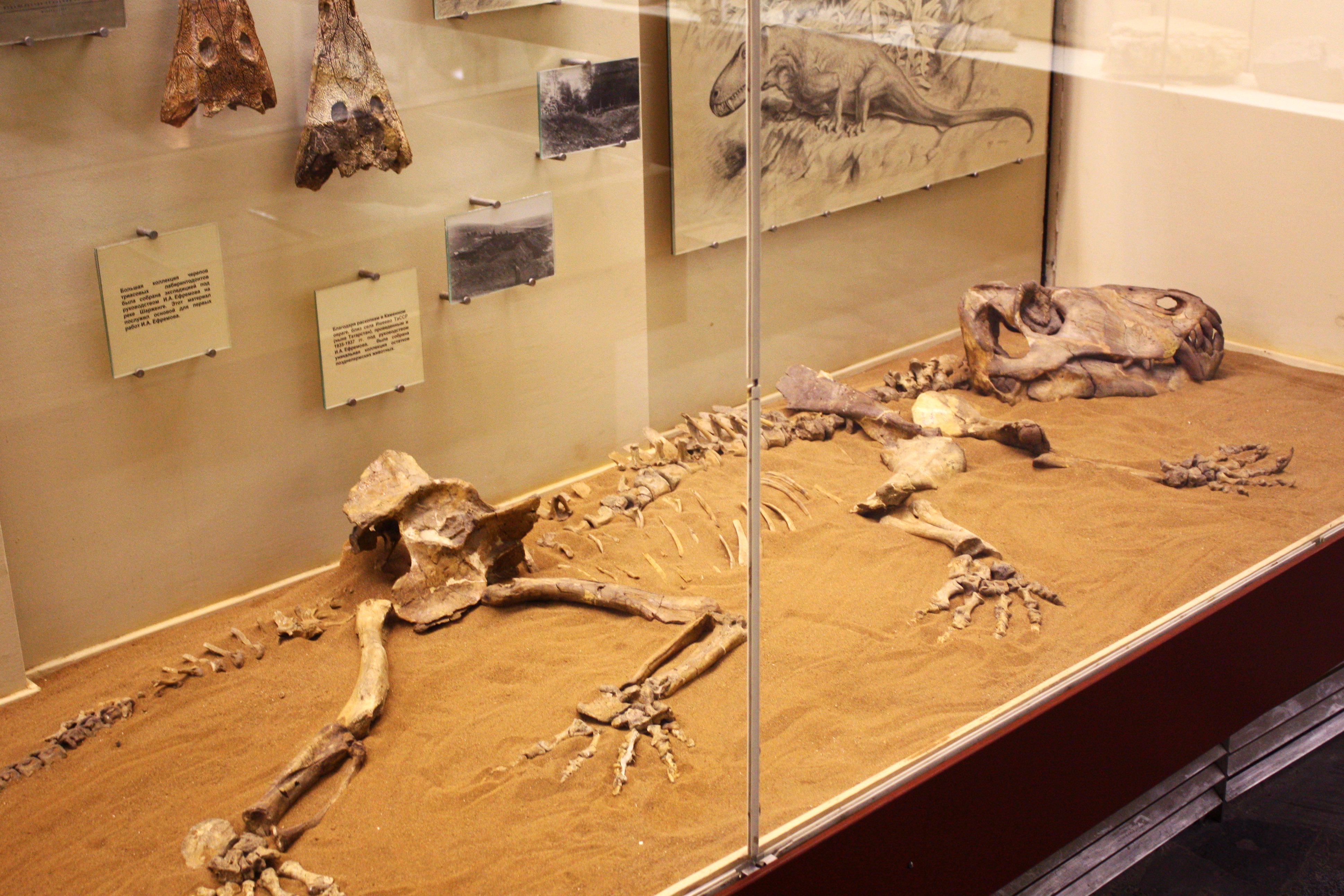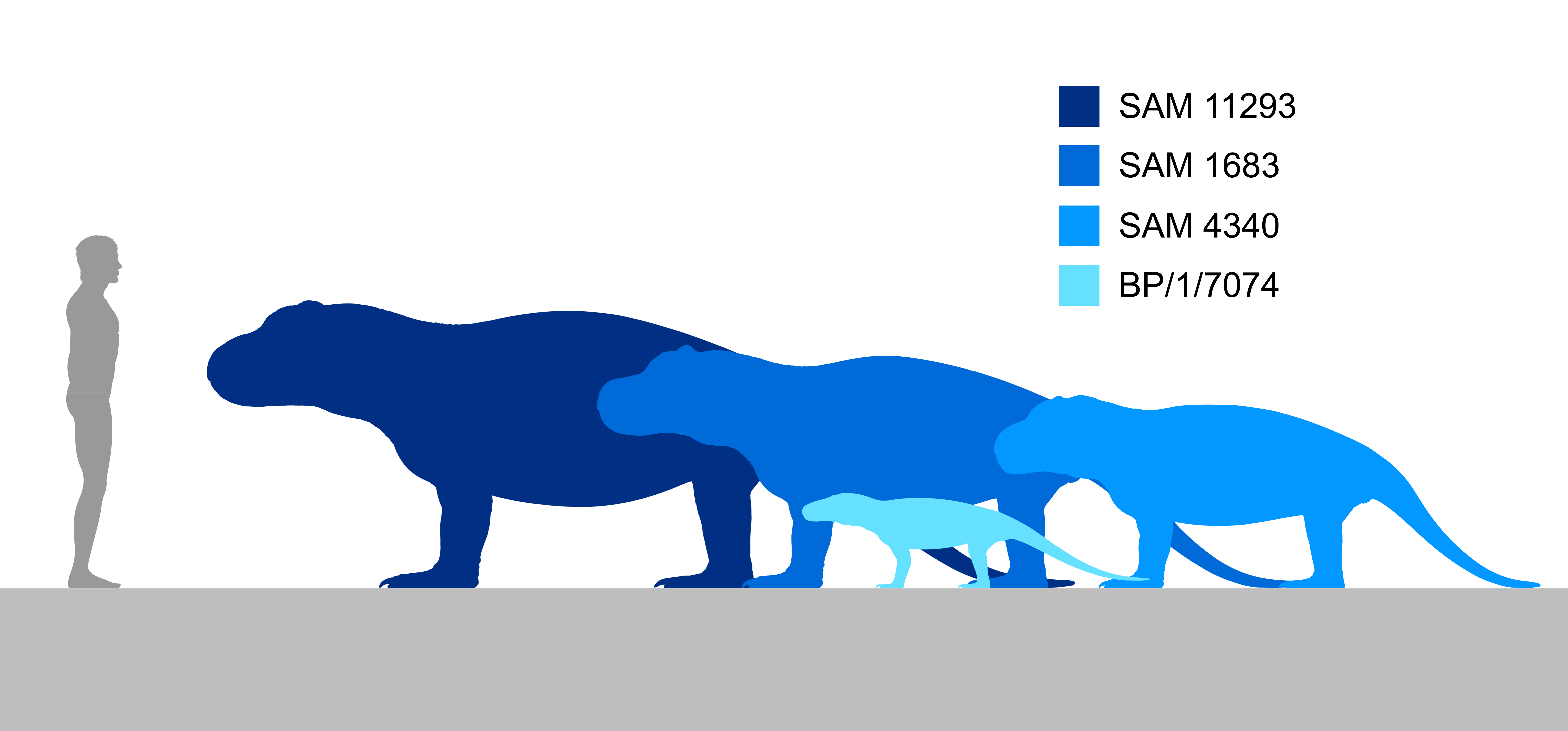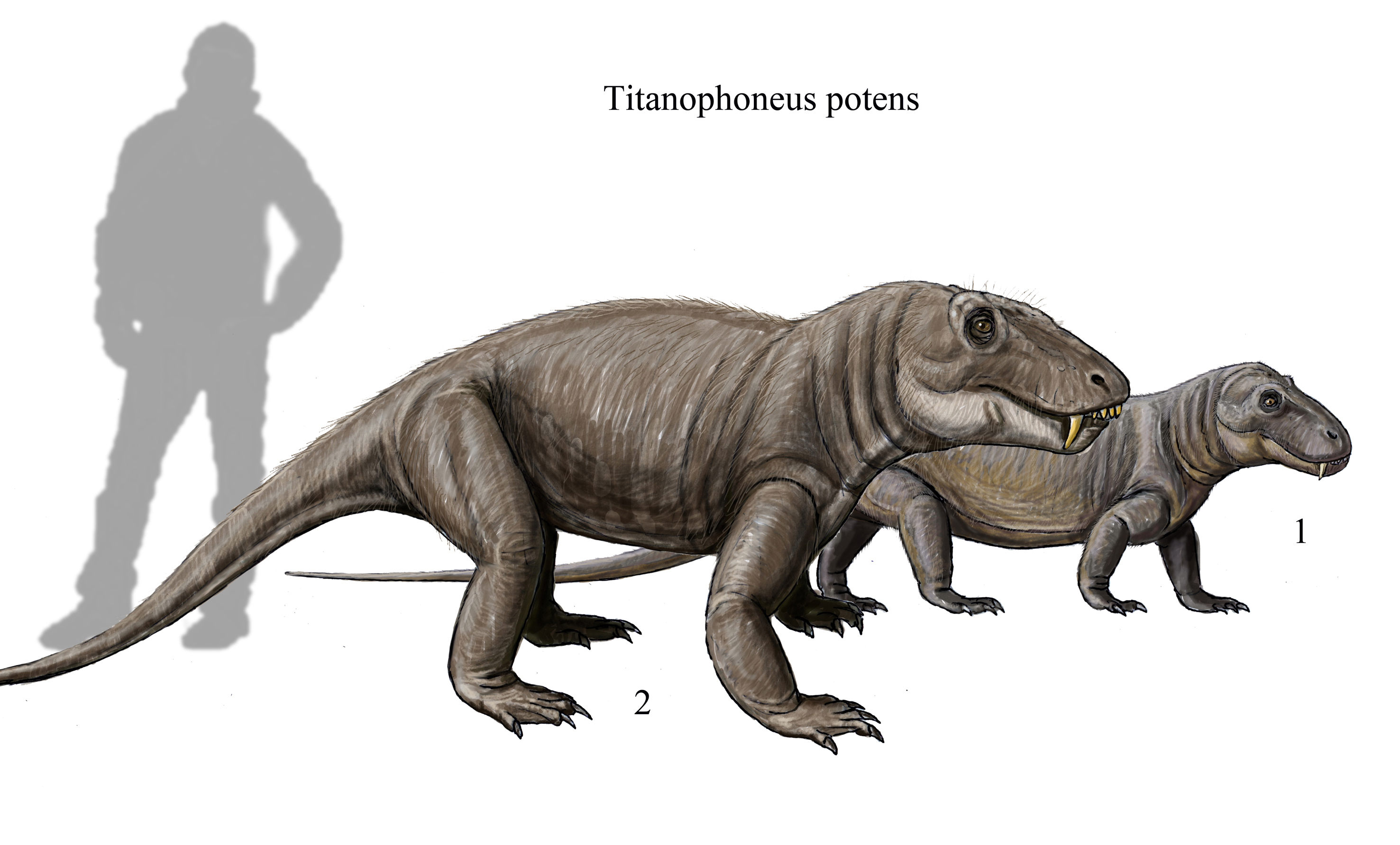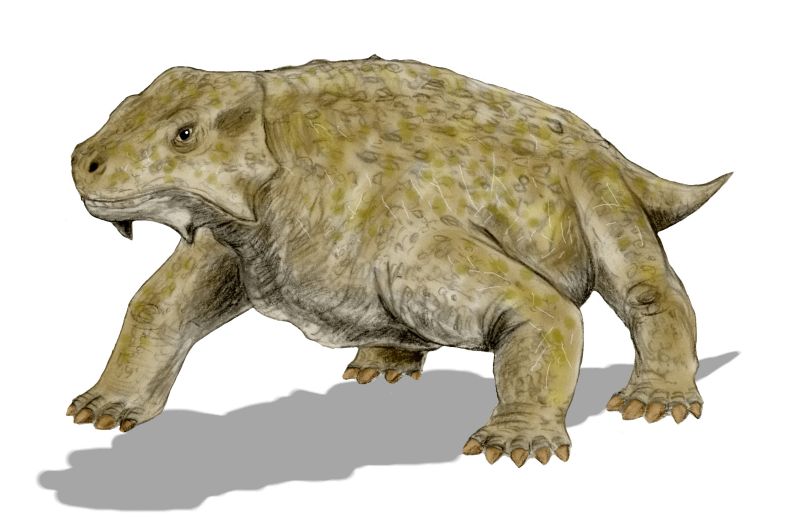|
Anteosaurs
Anteosaurs are a group of large, primitive carnivorous dinocephalian therapsids with large canines and incisors and short limbs, that are known from the Middle Permian of South Africa, Russia, China, and Brazil. Some grew very large, with skulls long, and were the largest predators of their time. They died out at the end of the Middle Permian, possibly as a result of the extinction of the herbivorous Tapinocephalia on which they may have fed. Description The Anteosauria are distinguished from the Tapinocephalia by several features, such as very large canines, cheek teeth with bulbous crowns, and an upturning of the premaxilla, so that the front of mouth curves strongly upwards. There is a tendency especially in more advanced forms such as '' Anteosaurus'' towards thickening of the bones of the top of the skull, indicating head-butting behavior. There is a large canal for the pineal organ (third eye); probably tied in with the animal's diurnal and seasonal cycles. The shoul ... [...More Info...] [...Related Items...] OR: [Wikipedia] [Google] [Baidu] |
Anteosaurus
''Anteosaurus'' (meaning "Antaeus lizard") is an extinct genus of large carnivorous dinocephalian synapsid. It lived at the end of the Guadalupian (= Middle Permian) during the Capitanian age, about 265 to 260 million years ago in what is now South Africa. It is mainly known by cranial remains and few postcranial bones. Measuring long and weighing about , ''Anteosaurus'' was the largest known carnivorous synapsid, non-mammalian synapsid and the largest terrestrial predator of the Permian period. Occupying the top of the food chain in the Middle Permian, its skull, jaws and teeth show adaptations to capture large prey like the giants Titanosuchidae, titanosuchids and Tapinocephalidae, tapinocephalids dinocephalians and large Pareiasauromorpha, pareiasaurs. As in many other dinocephalians the cranial bones of ''Anteosaurus'' are pachyostosis, pachyostosed, but to a lesser extent than in tapinocephalid dinocephalians. In ''Anteosaurus'', pachyostosis mainly occurs in the form of hor ... [...More Info...] [...Related Items...] OR: [Wikipedia] [Google] [Baidu] |
Archaeosyodon DB
''Archaeosyodon'' is an extinct genus of dinocephalian therapsids. It was medium-sized, reaching about 1.5–2 m (4–5 ft) in length. See also * List of therapsids This list of therapsids is an attempt to create a comprehensive listing of all Genus, genera that have ever been included in the Therapsida excluding mammals and purely vernacular terms. The list includes all commonly accepted genera, but also gene ... References Anteosaurs Prehistoric therapsid genera Permian synapsids of Asia Prehistoric synapsids of Europe Guadalupian synapsids Fossil taxa described in 1960 Guadalupian genus first appearances Guadalupian genus extinctions {{paleo-therapsid-stub ... [...More Info...] [...Related Items...] OR: [Wikipedia] [Google] [Baidu] |
Titanophoneus
''Titanophoneus'' ("titanic murderer") is an extinct genus of carnivorous dinocephalian therapsid from the Middle Permian. It is classified within the family Anteosauridae. The type species is ''Titanophoneus potens''. Remains of ''Titanophoneus'' have been found at Isheevo, Russia. Description An adult skull would have reached 80 cm with a heavy long snout. The long tail and short limbs show the species to be a primitive therapsid, unlike '' Inostrancevia,'' which was more advanced. The structure of the limbs and the density of the bone are designed for a sprawling stance. The temporal opening is more advanced than Estemmenosuchidae, but less advanced than ''Inostrancevia''. The teeth are large with 12 large palate incisors followed by 2 canines and various smaller back teeth. The lower palate is the same as the upper but without the canine teeth. The appearance of ''Titanophoneus'' is reminiscent to the sphenacodontid pelycosaurs, which included '' Dimetrodon''. Ga ... [...More Info...] [...Related Items...] OR: [Wikipedia] [Google] [Baidu] |
Titanophoneus Moscow
''Titanophoneus'' ("titanic murderer") is an extinct genus of carnivorous dinocephalian therapsid from the Middle Permian. It is classified within the family Anteosauridae. The type species is ''Titanophoneus potens''. Remains of ''Titanophoneus'' have been found at Isheevo, Russia. Description An adult skull would have reached 80 cm with a heavy long snout. The long tail and short limbs show the species to be a primitive therapsid, unlike ''Inostrancevia,'' which was more advanced. The structure of the limbs and the density of the bone are designed for a sprawling stance. The temporal opening is more advanced than Estemmenosuchidae, but less advanced than ''Inostrancevia''. The teeth are large with 12 large palate incisors followed by 2 canines and various smaller back teeth. The lower palate is the same as the upper but without the canine teeth. The appearance of ''Titanophoneus'' is reminiscent to the sphenacodontid pelycosaurs, which included ''Dimetrodon''. Gallery F ... [...More Info...] [...Related Items...] OR: [Wikipedia] [Google] [Baidu] |
Anteosaurus Magnificus BW Lateral
''Anteosaurus'' (meaning "Antaeus lizard") is an extinct genus of large carnivorous dinocephalian synapsid. It lived at the end of the Guadalupian (= Middle Permian) during the Capitanian age, about 265 to 260 million years ago in what is now South Africa. It is mainly known by cranial remains and few postcranial bones. Measuring long and weighing about , ''Anteosaurus'' was the largest known carnivorous non-mammalian synapsid and the largest terrestrial predator of the Permian period. Occupying the top of the food chain in the Middle Permian, its skull, jaws and teeth show adaptations to capture large prey like the giants titanosuchids and tapinocephalids dinocephalians and large pareiasaurs. As in many other dinocephalians the cranial bones of ''Anteosaurus'' are pachyostosed, but to a lesser extent than in tapinocephalid dinocephalians. In ''Anteosaurus'', pachyostosis mainly occurs in the form of horn-shaped supraorbital protuberances. According to some paleontologists t ... [...More Info...] [...Related Items...] OR: [Wikipedia] [Google] [Baidu] |
Goat
The goat or domestic goat (''Capra hircus'') is a species of Caprinae, goat-antelope that is mostly kept as livestock. It was domesticated from the wild goat (''C. aegagrus'') of Southwest Asia and Eastern Europe. The goat is a member of the family Bovidae, meaning it is closely related to the sheep. It was one of the first animals to be domesticated, in Iran around 10,000 years ago. Goats have been used for milk, Goat meat, meat, Animal fur, wool, and Animal skin, skins across much of the world. Milk from goats is often turned into goat cheese, cheese. In 2022, there were more than 1.1 billion goats living in the world, of which 150 million were in India. Goats feature in mythology, folklore, and religion in many parts of the world, including in the classical myth of Amalthea (mythology), Amalthea, in Tanngrisnir and Tanngnjóstr, the goats that pulled the chariot of the Norse god Thor, in the Scandinavian Yule goat, and in Hinduism's goat-headed Daksha. In Christianity and ... [...More Info...] [...Related Items...] OR: [Wikipedia] [Google] [Baidu] |
Pachycephalosauria
Pachycephalosauria (; from Greek παχυκεφαλόσαυρος for 'thick headed lizards') is a clade of ornithischian dinosaurs. Along with Ceratopsia, it makes up the clade Marginocephalia. With the exception of two species, most pachycephalosaurs lived during the Late Cretaceous Period, dating between about 85.8 and 66 million years ago. They are exclusive to the Northern Hemisphere, all of them being found in North America and Asia. They were all bipedal, herbivorous/omnivorous animals with thick skulls. Skulls can be domed, flat, or wedge-shaped depending on the species, and are all heavily ossified. The domes were often surrounded by nodes and/or spikes. Partial skeletons have been found of several pachycephalosaur species, but to date no complete skeletons have been discovered. Often isolated skull fragments are the only bones that are found. Candidates for the earliest-known pachycephalosaur include ''Ferganocephale adenticulatum'' from Middle Jurassic Period strata ... [...More Info...] [...Related Items...] OR: [Wikipedia] [Google] [Baidu] |
Dinosaurs
Dinosaurs are a diverse group of reptiles of the clade Dinosauria. They first appeared during the Triassic Geological period, period, between 243 and 233.23 million years ago (mya), although the exact origin and timing of the #Evolutionary history, evolution of dinosaurs is a subject of active research. They became the dominant terrestrial vertebrates after the Triassic–Jurassic extinction event 201.3 mya and their dominance continued throughout the Jurassic and Cretaceous periods. The fossil record shows that birds are feathered dinosaurs, Evolution of birds, having evolved from earlier Theropoda, theropods during the Late Jurassic epoch, and are the only dinosaur lineage known to have survived the Cretaceous–Paleogene extinction event approximately 66 mya. Dinosaurs can therefore be divided into avian dinosaurs—birds—and the extinct non-avian dinosaurs, which are all dinosaurs other than birds. Dinosaurs are varied from taxonomy (biology), taxonomic, ... [...More Info...] [...Related Items...] OR: [Wikipedia] [Google] [Baidu] |
Titanothere
Brontotheriidae is a family of extinct mammals belonging to the order Perissodactyla, the order that includes horses, rhinoceroses, and tapirs. Superficially, they looked rather like rhinos with some developing bony nose horns, and were some of the earliest mammals to have evolved large body sizes of several tonnes. They lived around 56–34 million years ago, until the very close of the Eocene. Brontotheres had a Holarctic distribution, with the exception of Western Europe: they occupied North America, Asia, and Eastern Europe. They were the first fossilized mammals to be discovered west of the Mississippi, and were first discovered in South Dakota. Characteristics and evolution This group has also been referred to as "Titanotheres." "Titan" refers to the mythological Greek gods who were symbols of strength and large size, and "theros" is Greek for "wild animal." "Bronto" is Greek for "thunder," which may be how this group got the nickname "thunder beasts." Brontotheres retai ... [...More Info...] [...Related Items...] OR: [Wikipedia] [Google] [Baidu] |
Middle Permian
The Guadalupian is the second and middle series/epoch of the Permian. The Guadalupian was preceded by the Cisuralian and followed by the Lopingian. It is named after the Guadalupe Mountains of New Mexico and Texas, and dates between 272.95 ± 0.5 – 259.1 ± 0.4 Mya. The series saw the rise of the therapsids, a minor extinction event called Olson's Extinction and a significant mass extinction called the end-Capitanian extinction event. The Guadalupian is also known as the Middle Permian. Name and background The Guadalupian is the second and middle series or epoch of the Permian. Previously called Middle Permian, the name of this epoch is part of a revision of Permian stratigraphy for standard global correlation. The name "Guadalupian" was first proposed in the early 1900s, and approved by the International Subcommission on Permian Stratigraphy in 1996. References to the Middle Permian still exist. The Guadalupian was preceded by the Cisuralian and followed by the Lopingian. ... [...More Info...] [...Related Items...] OR: [Wikipedia] [Google] [Baidu] |
Pareiasaur
Pareiasaurs (meaning "cheek lizards") are an extinct clade of large, herbivorous parareptiles. Members of the group were armoured with osteoderms which covered large areas of the body. They first appeared in southern Pangea during the Middle Permian, before becoming globally distributed during the Late Permian. Pareiasaurs were the largest reptiles of the Permian, some reaching sizes over , equivalent to the largest contemporary therapsids. Pareiasaurs became extinct in the end-Permian mass extinction event. Description Pareiasaurs ranged in size from long, with some species estimated to exceed in body mass. The limbs of many parieasaurs were extremely robust, likely to account for the increased stress on their limbs caused by their typically sprawling posture. The cow-sized '' Bunostegos'' differed from other pareiasaurs by having a more upright limb posture, being amongst the first amniotes to develop this trait. Pareiasaurs were protected by bony scutes called osteoderms ... [...More Info...] [...Related Items...] OR: [Wikipedia] [Google] [Baidu] |
Biarmosuchia
Biarmosuchia is an extinct clade of non-mammalian synapsids from the Permian. Biarmosuchians are the most basal group of the therapsids. They were moderately-sized, lightly built carnivores, intermediate in form between basal sphenacodont " pelycosaurs" and more advanced therapsids. Biarmosuchians were rare components of Permian ecosystems, and the majority of species belong to the clade Burnetiamorpha, which are characterized by elaborate cranial ornamentation. Characteristics The biarmosuchian skull is very similar to the sphenacodontid skull, differing only in the larger temporal fenestra (although these are still small relative to later therapsids), slightly backward-sloping occiput (the reverse of the pelycosaur condition), reduced number of teeth, and single large canine teeth in both upper and lower jaws, and other features (Carroll 1988 pp. 370, Benton 2000 p. 114). In later specialised Biarmosuchia, these resemble the enlarged canines of the Gorgonopsia. T ... [...More Info...] [...Related Items...] OR: [Wikipedia] [Google] [Baidu] |








